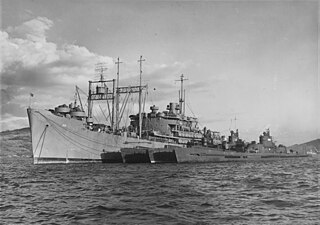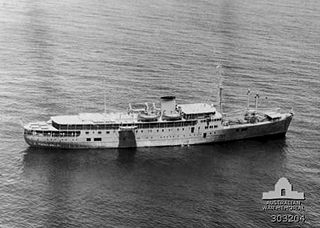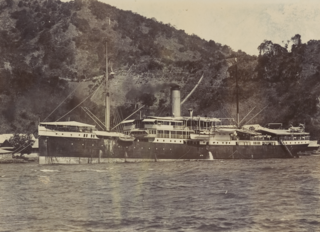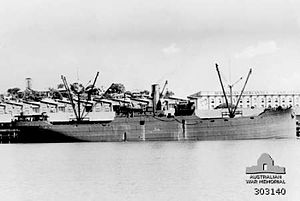
The China Navigation Company. Pte. Ltd. is registered in Singapore — with parent entity The China Navigation Company Limited (CNCo), trading as Swire Shipping & Swire Bulk — is a merchant shipping company based in Singapore. It is part of the Swire group, formerly John Swire and Sons.


USS Euryale (AS-22) was built as the Hawaiian Merchant by the Federal Shipbuilding and Drydock Company in Kearny, New Jersey for the Matson Navigation Company. Hawaiian Merchant was launched 12 April 1941, minutes after sister ship Hawaiian Shipper, and was completed April 1941. Matson intended the ship to join Hawaiian Planter and Hawaiian Shipper in the U.S. Pacific Coast—Australia route. The ship was under United States Army Transportation Corps charter when the United States went to war and came under the control of the War Shipping Administration which allocated the ship to the Army's continued charter until the ship was purchased 15 April 1943 by the United States Navy and commissioned 2 December 1943 as USS Euryale (AS-22), serving as a submarine tender through the war. Euryale was decommissioned 7 October 1946, going into reserve until 9 August 1972 when she was delivered to the Maritime Administration with immediate sale to American Ship Dismantler, Inc. for disposal.
The Pensacola Convoy is a colloquialism for a United States military shipping convoy that took place in late 1941 as the Pacific War began. The name was derived from that of its primary escort ship, the heavy cruiser USS Pensacola. Pensacola was officially designated Task Group 15.5 and Army sources may use the term Republic convoy for the senior convoy vessel. The convoy, dispatched in peacetime, was intended to reinforce the United States Army Forces Far East (USAFFE), created to defend the U.S. Commonwealth of the Philippines and commanded by General Douglas MacArthur, with artillery, aircraft, munitions and fuel, as the threat of war with the Empire of Japan loomed. After war broke out, and Japanese forces attacked the Philippines, the convoy was diverted to Brisbane, Australia.

USAT Thomas H. Barry, formerly SS Oriente, was a Ward Line ocean liner that became a United States Army troopship in the Second World War. She was intended for transfer to the United States Navy and assigned the hull number AP-45, but was not transferred and remained with the Army.
USAT J. W. McAndrew was a Type C3-P&C troop ship for the United States Army during World War II.
Several steamships have borne the name Westfalen, after the Westphalia region in Germany:

Dona Nati was one of three identical cargo ships built in 1939 by Cantieri Riuniti dell'Adriatico, San Marco, Trieste, Italy, for the De La Rama Steamship Company, Inc., Iloilo, Philippines, intended for service between the Philippines West Coast and North America. The ship was engaged in normal commerce until it became a key player in events in the Philippines after December 7, 1941, and the Japanese invasion of the islands. Dona Nati had arrived in Manila along with the ships President Grant, John Lykes, Cape Fairweather, and American Leader in a convoy escorted by the USS Boise (CL-47) on December 4, 1941. She had escaped to Australia where she became particularly notable as being one of only three ships to successfully run the Japanese blockade in attempts to supply the forces cut off in the Philippines. The ship was retained under Army control and on April 28, 1943, was one of twenty-eight vessels forming the fleet available to the Southwest Pacific command under General MacArthur.

Don Isidro, delivered in 1939, was the second and larger of two Krupp built motor ships of De La Rama Steamship Company, Iloilo, Philippines in inter-island service. The ship was under charter by the United States Army as a transport during the Japanese invasion of the Philippines. As defending forces became cut off from supply by the Japanese blockade Don Isidro was one of eight ships, only three of which were successful, known to make an attempt to run the blockade. In that attempt, under her captain Rafael J. Cisneros, Don Isidro became involved in the 19 February Japanese attack on Darwin, Australia where, though not in the port, she was strafed, bombed and left off Bathurst Island burning with all lifeboats destroyed. The captain attempted to make land when she grounded about three miles off Melville Island to which survivors swam. Of the sixty-seven crew and sixteen soldiers aboard eleven of the crew and one soldier were killed or missing. Survivors were rescued by HMAS Warrnambool, taken to Darwin, treated at the hospital and then awaited orders at the 147th Field Artillery camp.

Don Esteban, delivered in 1936, was the first and smaller of two Krupp built motor ships of the De La Rama Steamship Company, Iloilo, Philippines in inter-island service. The ship was under a bareboat charter by the United States Army as a transport on 30 October 1941 for use in pre positioning U.S. Army Air Corps (USAAC) fuel and munitions in the southern Philippines, Netherlands East Indies, Singapore and Australia. After the Japanese invasion of the Philippines she evacuated personnel from the Army headquarters, including General MacArthur, from Manila to Corregidor on Christmas Eve, 1941. The ship was lost off Mindoro on 2 March 1942 while continuing its supply missions.

MS Sea Witch was a United States Maritime Commission type C2 cargo ship, the first of four pre-war hulls, built by Tampa Shipbuilding & Engineering Company, Tampa, Florida and delivered in July 1940. The ship was of the basic C2 design, rather than the more numerous C2-S, C2-S-A1, C2-S-B1 types and four C2-T hulls delivered December 1941 through March 1942. Sea Witch was one of the relatively few C2 types built with diesel engines.

Registan, built 1910, was the first name for a ship serving fifty years under the later names Guantanamo, USS Guantanamo (ID-1637), Comerio, Vittorin, Grey Lag and finally Hai Lung until scrapping in 1960. The ship transported gunpowder and munitions during World War I as USS Guantanamo and as a cargo ship during World War II for the War Shipping Administration (WSA). After 12 October 1943 the ship was assigned to the Southwest Pacific Area command's permanent local fleet as the United States Army transport Grey Lag with that fleet's number X-101. In April 1945 she was one of the transports towing large barges from Australia and New Guinea to the Philippines after that concept to mitigate shipping shortages had been proven feasible. In 1946 the ship was sold to the Republic of China and renamed Hai Lung.

SS Japara was a freighter of 3,323 GRT built by Mach. Fabr. & Scheepswerf P. Smit Jr., Rotterdam in 1930 and operated by Koninklijke Paketvaart-Maatschappij (KPM) in the Dutch East Indies trade. The 1930 Japara was operating with the United States Army permanent local fleet of the U.S. Army Forces in Australia (USAFIA) from 1942 until 1945 even while the larger ship, 9,312 GRT MS Japara (1938), was active in Army service oceanwide. Japara of 1930 played an important logistics role in the New Guinea Campaign.

SS Van Heemskerk was a passenger steamship that was launched in the Netherlands in 1909 and sunk by enemy action off New Guinea in 1943. She spent most of her career with Koninklijke Paketvaart-Maatschappij, based in the Dutch East Indies.

SS Sierra Cordoba was a Norddeutscher Lloyd passenger and cargo ship completed 1913 by AG Vulcan Stettin. The ship operated between Bremen and Buenos Aires on the line's South American service and was equipped with wireless and "submarine sounding apparatus" with accommodations for 116 first class, 74 second class and 1,270 "between decks" passengers. A description after the ship had been seized and restored in 1919 noted she was among the fastest and best equipped ships of the line with accommodations for 115 first class passengers and 1,572 third and steerage class passengers as well as a crew of 179 officers and men.

SS President Taft was launched as one of the "state" ships, Buckeye State, completed by the United States Shipping Board as cargo passenger ships after originally being laid down as troop transports. Buckeye State had been laid down as Bertrice but was converted and renamed before launching. Originally assigned to the Matson Navigation Company as the Shipping Board's agent, the ship was later renamed President Taft and assigned to Pacific Mail Steamship Company for operation. In 1925 the Shipping Board sold the ship to Dollar Steamship Company. President Taft was operated by Dollar and then its successor American President Lines until requisitioned by the War Department on 17 June 1941.
Portmar was a United States-flagged merchant vessel that was constructed in response to World War I, operated by a succession of companies in the interwar period, then taken up for wartime shipping in World War II.

SS Admiral Halstead was a merchant ship built in 1920 by the Submarine Boat Corporation, Newark, New Jersey, and operating originally as Suwordenco. The ship's history illustrates the state of the industry as the massive World War I shipbuilding program transitioned to an effort to sell and operate hulls in a market glutted by wartime shipbuilding. By the outbreak of World War II Suwordenco was one of the few ships operating as its owners went bankrupt. The ship was bought for operation from the Puget Sound to California ports until it was caught up in the prelude to the United States' entry into the war.

SS Rufus King was a standard Liberty ship built in the United States during World War II. She was named after Founding Father Rufus King, and was wrecked in July 1942, upon Amity Bar South of Moreton Island and north of North Stradbroke Island, Queensland, Australia. She was operated by International Freighting Corporation under charter with the Maritime Commission and War Shipping Administration.
MVEmilia was a passenger/cargo ship that operated in the intracoastal waterways of the Commonwealth of the Philippines. She was sunk in March 1942 by a Japanese destroyer.















